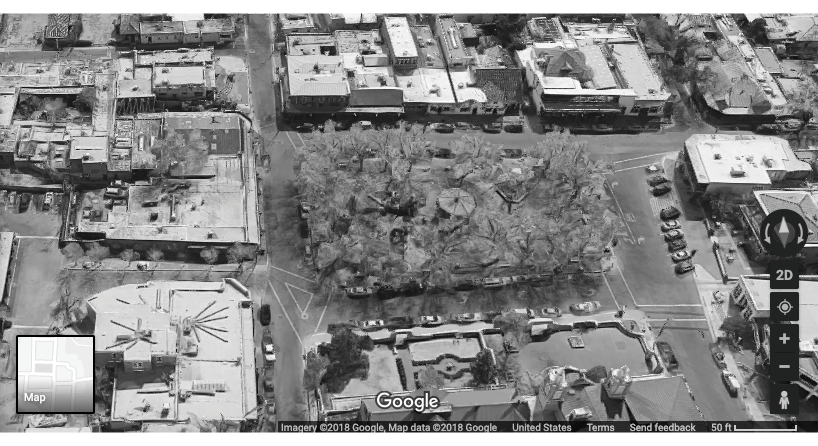…At the edges of a Pedestrian Sanctuary, identify key sites, especially corners, for the provision of neighborhood public spaces.

__Problem-statement: At the scale of neighborhoods — roughly 1-2 square kilometers, or ½ square mile — there is a need for a lively public space for gathering, recreation, markets, and community events, adjacent to neighborhood commercial activities. This need is different from the need for recreational “green” parks.__

Old Town Plaza in Albuquerque, New Mexico, a classic neighborhood square following the “Laws of the Indies” regulations that required squares to be placed at the center of commercial and civic activity.¹
Discussion: The size of urban squares and plazas can vary, and some can be quite small. The critical factor is the maximum distance that residents must walk to reach these spaces — optimally a maximum of 400 meters or ¼ mile. This in turn suggests a spacing of roughly 800 meters or ½ mile in all directions.
We rely upon a fractal distribution in the sizes of public squares, in which the neighborhood square represents an intermediate size. This smaller, distributed square cannot be substituted by a larger or equal size “green” park, because both size and function are important.²
__Therefore: Create neighborhood squares adjacent to neighborhood through streets, and at nodes where commercial activities are present or likely. Place them where climatic and other physical conditions make sitting there attractive.__

At the edges of the neighborhood squares, place at least some active commercial uses in each Perimeter Building, positioning carefully for economic success. Develop a Place Network along the streetscape, and assure the Walkable Streetscape all around the square…
notes
¹ See a description of the Laws of the Indies and their generative capabilities in Hakim, B. S. (2007). Generative processes for revitalizing historic towns or heritage districts. Urban Design International, 12(2-3), 87-99. It is worth noting that the Old Town Plaza is now very much an anomaly in the wider Albuquerque cityscape, and the pattern expressed in the Laws of the Indies has not survived into contemporary growth. Nonetheless we can see such spaces as instructive exemplars within the context of multiscalar networked interventions.
² A good description of successful neighborhood square structure as it has evolved in a European context — similar to but not identical to other international contexts — can be seen at Lennard, C. H. & Lennard, L. H. (2008). Genius of the European Square. Portland: International Making Cities Livable.
See more Neighborhood Patterns